![]()
A proud member of the internet since
1995.
Our sites:
Home
of
Access Heritage Inc (formerly The Discriminating General)
The Napoleonic Wars Collection
Military Music Sound Clip Gallery
Products and Services:
British Army Products 1793-1815
British Army Products 1816-1856

Articles - Reenactments and Units - Book Reviews - Quizzes - Replicas - Links - Chart of British Regiments - Sound Clips - Prints for Sale - Animated GIF Battles - Chronology of Events - Video Clips
Assistant
Surgeon William Faulkner
of the 41st Regiment during the War of 1812
by Robert Henderson
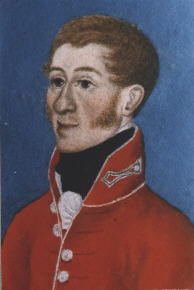
Miniature Portrait of Assistant Surgeon of the 41st Regiment, c.1811 (private coll.)
History of the 41st Regiment
Arriving in Canada in August 1799 from Cork, Ireland, the 41st Regiment of Foot began what was to be a fifteen year stay in Canada's frontier garrisons along the US border. When war was declared on Great Britain by the United States in June 1812 the 41st Regiment was one of only a few regiments stationed to protect Canada. The American boasts of the taking of Canada being "a mere matter of marching" seemed a fair assessment at the opening of the war. However, Major General Isaac Brock, commander of Anglo-Canadian forces in Upper Canada (present day Ontario) had other plans.
With the outbreak of war, the British soldiers at Fort St. Joseph quickly attacked and captured Fort Michlimackinac on the upper Michigan peninsula. The American General Hull at Detroit also took the offensive. However after crossing the river to the Canadian side in July, Hull found himself harassed by skirmishing 41st soldiers and Indians. At one point a 41st detachment ambushed a convoy escort and captured a number of Hull's dispatches. Uncomfortable with his position, Hull withdrew with the bulk of his forces to Detroit. The following month, Brock arrived from Niagara with reinforcements, crossed the river and prepared to assault Detroit with his small army. Believing that Brock had a larger force and fearing possible Indian atrocities, Hull surrendered Detroit and his army.
Upon returning to the Niagara frontier, Brock turned to address a new invading force, this time along the Niagara river at Queenston Heights on October 13. After US forces gained the heights Brock lead a charge to dislodge his well-positioned foe. The result was the mortal wounding of Brock and the repulse of the British and Canadians. The timely arrival of a detachment of the 41st Regiment resulted in a new and this time successful attempt to clear the heights. The Americans retreated back across the river.
By the beginning of 1813, most of the 41st Regiment concentrated at Fort Malden along the Detroit frontier. The offence was quickly taken up in the new year against the Ohio territory. In January, the British attacked and defeated a poorly clothed and equipped American force at Frenchtown (River Raisin). By May, Fort Meigs (near Toledo) was laid siege to. While the 41st were unable to take the fort, a large American relief force was routed. The 41st Regiment's fortunes changed in August of 1813. A poorly-planned assault of Fort Stephenson on the Sandusky river resulted in heavy 41st casualties and a withdrawal by the British back to Fort Malden. In September a number of 41st were detached as marines in the small lake fleet that met defeat against US Admiral Perry at Put-In-Bay. With US forces advancing and Lake Erie in the hands of the Americans, Fort Malden was abandoned and a retreat began east into the interior. Encumbered by heavy baggage, US forces quickly caught up and captured most of what was left of the 41st at the Battle of the Thames. Of the over 800 men of the regiment, only 180 escaped including the grenadier and light companies with the regiment's colours.
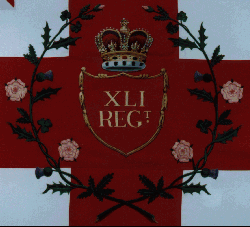
Reproduction of the Regimental Colour of the 41st Regiment
The Battle of the Thames did not end the service of the 41st in the war. Raised the year earlier, the 400 strong 2nd Battalion of the Regiment arrived in Canada in May 1813. Upon arriving on the Niagara Peninsula, the remnants of the 1st were merged with the 2nd Battalion. Reborn, the 41st Regiment set about correcting the errors of the Battle of the Thames. In December 1813, a detachment of the regiment participated in the daring capture of Fort Niagara at the mouth of the Niagara river. Following this, the regiment served in the defeat of American forces at Black Rock near Buffalo, New York in July 1813. In the most hotly contested engagement of the war, British forces were able to halt an advancing American Army at Lundy's Lane (near Niagara Falls, Canada). The 41st Light Company suffered 50% casualties. The British pursued the retreating American army to Fort Erie were an unsuccessful assault was made resulting in heavy casualties to the flank companies of the regiment. This was the last engagement for the 41st Regiment during the war. The following spring the regiment departed for Belgium, narrowly missing the Battle of Waterloo but joining the Allied army's occupation of Paris.
The 41st Regiment of Foot's service in the War of 1812 was instrumental in making Canada more than "a mere matter of marching". Today the 41st Regiment is recreated at Fort George National Historic Site in Niagara-on-the-Lake, Canada. There you can see exhibits, furnished barracks and officer quarters, and musket drill and music demonstrations. The displays at Fort Malden National Historic Site commemorate the services of the regiment on the Detroit frontier. Further information on these two Parks Canada sites can be found at that organization's website through our links page. Contacting the regimental museum is also another avenue to pursue. Its address is: The Welsh Regiment Museum, Black & Barbican Towers, Cardiff Castle, Cardiff, Glamorgan, CF1 2RB WALES.
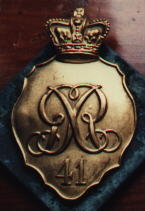
William Faulkner's 1812 pattern Shako Plate (private coll.)
Biography of William Faulkner
At the age of 22 William Faulkner was commissioned as an Assistant Surgeon for the 41st Regiment in June 1810. By July 1811, Faulkner was noted in returns at Fort Malden. Accept for brief detached duties, Faulkner remained on the Detroit frontier until September 1813. It is presumed he would have participated in the forays of 1813 into the United States. During the retreat from Fort Malden, Faulkner was part of the lucky few who escaped back to the Niagara peninsula. Suffering from poor health Faulkner was transferred to Quebec City. After the war he went on a leave of absence. In July 1815 Faulkner rejoined his Regiment at St Denis, France and on then to Camp Bois de Boulogne. Upon his return to England, he exchanged to the 1st Royal Veteran Battalion at Frankfort barracks, Plymouth and after became the assistant surgeon at Pendennis Castle. The hospital block still remains and is open to the public. On 20th May 1816, the 1st Royal Veteran battalion was disbanded and William Faulkner returned to his birthplace in Huntingdonshire were he married Ann Bond Gray on18th September 1816. After taking up residence in Potton, Bedfordshire, Faulkner opened his own practice as a surgeon. On 2nd December 1823, William Faulkner at the age of thirty-six died. Inscribed on his tombstone, the reason for his early death was from "an affectation of the lungs due to his service in Canada" His widow applied for and received an Army pension.
Surgeon's Uniform of the 41st Regiment
When William Faulkner joined the 41st Regiment, each officer wore a double-breasted scarlet, superfine wool, long-tailed coat with red faced collar, lapels, and cuffs. The regimental lace was silver with a black line down the centre and was placed on the officer's coat in single-spaced "Jew's harp" bastion loops like the other ranks of the regiment. Arranging the
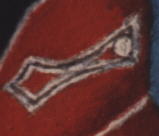
Detail of Faulkner's collar showing Jew's harp bastion loop
stiff metal lace into this shape was not an easy task for a tailor. Other portraits of 41st officers show these bastions crudely formed. Other regiments using bastion lace distinctions often had their officer coats decorated with square-ended loops. In 1812, officers of the 41st were ordered to changed their lace to 3/8" gold "warp" vellum with three bars on each side and their
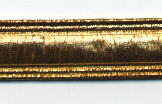
Example of two bar vellum lace (Access Heritage Inc (formerly The Discriminating General)'s collection)
loops were altered from bastion to squared-ended formations. Tailor books of the period describe the complete placement of the new lace on the coat: "10...loops on lapel, 4 on cuffs....Flaps laced round Backs & side edges laced diamond Hips Turnbacks laced." The officer button for the regiment before 1812 were silver, domed, with a '41' encircled by an eight pointed star. After 1812, the button became gilt with the cross of St. George encircled by an eight pointed star, '41' below the star and a crown above. The rim was decorated with a single row of diagonal leaves spiraling inward. To alleviate the plain look of a red faced red coat, white "feathering" or edging of white cassimere was added to the edges of the collar, lapels, pockets and turnbacks. The ornaments on the turnbacks were "gold admiral's stars, gold 41 in centre on silver oris". This was carried over into the 1812 coat. Also in 1812 a general change in the infantry officer's dress for the army as a whole was implemented (December 1811 regulation). Each officer's dress changed from a long-tailed coat, fore-and-aft chapeau bras (hat), white breeches, and hessian-style boots to a short tailed coat, 1812 pattern "belgic" shako, grey trousers, and short boots.
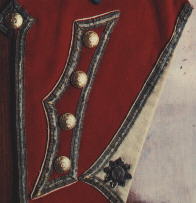
Tail of William Faulkner's coat- Dec.1811 Regulations (private coll.)
As a regimental assistant surgeon, William Faulkner wore a single-breasted coat like that of other regimental staff officers. General Orders from Horse Guards on11th April 1804 outlined the uniform for both general hospital staff and regimental surgeons as:
| [Hospital Staff Surgeons:]Scarlet Coat, single Breasted, with black Velvet Collar and Cuffs, slashed sleeves and skirts, yellow Hospital Staff buttons, one Epaulette on the Right Shoulder, embroidered with Gold on black Velvet, one Button on the Collar, one on the Cuffs, and two on the Sleeves; Cocked Hat, with black feather, black button, and black silk loop; blue pantaloons and Half boots; Black (waist) Sword Belt, Regulation Sword and Sword Knot, as approved for the Officer's of the Infantry.....The REGIMENTAL SURGEONS and ASSISTANTS to wear the Uniform of the Regiment, the Coat to be straight, without Facings, but with the Regiment Colour for Collar and Cuffs and each one Epaulette on the Right Shoulder. |
Edged with white, the front of the Faulkner's coat was decorated with red "twist button holes" and only the collar and the cuffs had regimental loops of lace. This was universal for other regiment surgeons, less the white edging. Note that the sash was not worn and it appears that the wearing of an epaulette varied. An original surgeon's coat of the 75th Regiment in a private collection shows no evidence of an epaulette being worn. William Faulkner is also illustrated without an epaulette. In contrast to this, a portrait of an 89th Regiment surgeon in the Royal Irish Fusiliers Museum shows an epaulette being worn. Also illustrated is the use of a black feather plume in the 1812 pattern shako.
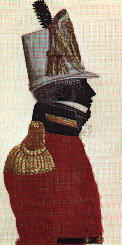
89th Surgeon in West Indies (Royal Irish Fusilier Museum)
Other items owned by an assistant surgeon are revealed in an incident in July 1807. Assistant Surgeon Korb of the 41st Regiment was rob of "a black body coat, fearnaought great coat, with a black cape, and Suwarrow boots, and ...a white beaver hat"(The York Gazette, 4th July 1807). The white beaver felt hat was likely an undress 'top' hat, convenient for the hot and humid Canadian summers.
Conclusion
Surgeons serving during the War of 1812 have provided invaluable accounts of their travels and experiences. The recollections of William 'Tiger' Dunlop of the 89th Regiment, John Douglas of the 8th Regiment, and William Dent of the 9th Regiment not only allow us to understand life of a British officer in North America but provide valuable insight into diseases and medical practices of the period. William Faulkner's service and the artifacts left by him adds another piece to the puzzle of the War of 1812.
Copyright Access Heritage Inc (formerly The Discriminating General) 1997
Copyright: Unless otherwise noted, all information, images, data contained within this website is protected by copyright under international law. Any unauthorized use of material contained here is strictly forbidden. All rights reserved.

